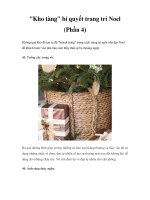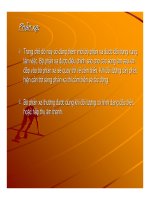SUSTAINABLE BUILDING DESIGN phần 4 ppsx
Bạn đang xem bản rút gọn của tài liệu. Xem và tải ngay bản đầy đủ của tài liệu tại đây (1.05 MB, 10 trang )
30
31
viii
GLOBAL SUSTAINABLE DESIGN&RESEARCH
33
SUSTAINABLE DESIGN COURSE FOR FUTURE ARCHITECTS
Students design passive architectural forms after learning the theoretical course in Architectural insti-
tute of FESTU last five years. Theoretical course of ARHITECTURAL CLIMATOLOGY (third year stu-
dents, 60-75 people every spring) describe the main principles of Sustainable design (with the excep-
tion of natural constructions and plasters). I give more attention in my lections of modification the
microclimatic conditions of open and closed space using previously architectural forms (Interaction of
architectural and landscape forms with wind and sun).
One group of students (20-25 people) will be learning green design principles in practice during next
three years.
GREEN DESIGN STEPS FROM SIMPLE FORMS TO DIPLOMA DROUGHT INCLUDE:
1. Direct gain of south facade only. First project with passive solar design - Settlement center (third
year student projects, autumn). Passive solar design not compulsory, only for advanced students.
2.Simple architectural form with wind-break and solar heating possibility (A). Covers for kindergarten
for 10-12 children (third year student projects, spring). Compulsory practice in framework of theoret-
ical course.
3.Direct gain and natural ventilation of atrium space only. School for 250 pupils (four year student
projects, autumn). Passive solar design not compulsory, only for advanced students.
4.Passive heating and cooling, hot water and space heating by solar water collectors; wind-break
design of building and site (B). Low store dwelling or Single family house (four year student projects,
spring). Compulsory use all methods of passive and active solar design. May be natural construc -
tions and plasters.
5.Green design from passive and active solar heating to bionic exterior and interior imagine and
"green" graphic style of documents. Public building - urban complex (five year student projects,
autumn - spring). Green design not compulsory, only for advanced students.
After learning all green stages, advanced students will be ready for "Green diploma projects" (C), and
future Green practice. The main part of diploma project besides draughts is the essay about
Sustainable design principles.
There are three "green" graduate groups for the last five years: 2001, 2003, 2005 (June) - almost 60
students. And one group of 20 students will be in future - 2007, June.
All projects design for local climatic conditions of south Primorye, Russian Far East
Winter: November - March, north-north-west wind 7-12 m/s, up to 15 - 18 m/s; temperature -12 -20
C in January ; November and March approximately - 8 +8 C; all season sunny weather. Cold sum-
mer: April - June, south-east wind 5-7 m/s, up to 10 - 15 m/s; temperature +10 +16 C in June, up to
+20 +22 C some sunny days; humidity 100%, usually cloudy. Summer: July - August, south-east wind
5-10 m/s, up to 15 - 20 m/s; temperature +20 +25 C, humidity 100%, usually rainy.
Deviation direction of wind by hills (50 -150 m, up to 200 meters) may be 45 degrees.
SUSTAINABLE DESIGN COURSE
Pavel A. Kazantsev
Far East State Technical University, Vladivostok, Russia
34
ECOBOX
ANGEL DE DIEGO RICA
MADRID, SPAIN. 2003
The Fundacion Metropoli building was conceived as an experimental building which integrates two
fundamental criteria:
-The creation of a place of, and for the development of, innovation and creativity
-A commitment to bioclimatic processes
BIOCLIMATIC COMPONENTS
Sun Scoops-In addition to capturing solar energy for the building, the sun scoops also act as skylights
permitting the passage of heat throughout the winter months and reflecting light in the summer.
Thermal Energy Storage-The building enclosures are composed of materials which maximize its
energy efficiency and saving. The thick outer walls act as thermal energy stores that regulate the
temperature within the building
Ventilation and Geothermal Energy-Underground geothermal energy is transmitted and stored in the
thermal energy storage (a two-meter deep gravel pit) located underneath the building. Air from the
exterior is allowed to heat up or cool, depending on the season, by passing through this energy stor-
age. The heated/cooled air is then introduced into the interior spaces and building enclosure.
The Atrium and Motorised Windows-The building is maintained in positive pressure outward due air
that is introduced from the exterior through the ventilation system.
Louvers -The automatic louvers that are fitted around the structure allow personalized control of lumi-
nosity and direct solar radiation into the building. Photovoltaic Panels integrated with the Facade
Solar Panels-Production of heat and cold.
Vapour Absorption Chiller-In the summer, the vapour absorption chiller uses the hot water produced
by the solar panels for the production of cold water for the radiant floors
Radiant Floors and Ceilings-The radiant heating and cooling system circulates hot and cold water
through underfloor tubing. During the winter, the hot water comes from the solar panels, while in the
summer; the system uses the same water that has been cooled by the vapour absorption chiller.
Intelligent Regulation Systems -In general, the electrical systems monitor and regulate building tem-
perature depending on the needs of the different interior spaces, the external thermal conditions and
the energy accumulated from the solar panel and photovoltaic cells.
Obtained Results
Energy Savings of 70 %
35
36
37
Space, Light and nature are three concepts architect Carlos Garcia Velez y Cortazar has integrated
in this home of unsuspected shapes, with an architecture of pure lines, mixing curves and diagonals
in integrated in integral spaces. Down to the last detail, the project is imbued with a sense of privacy
and communion with nature.
The facade was realized as a curtain of mystery that, on being opened, allows one to see first a
lengthy corridor covered by a pergola formed by a ribs of glass, an element that creates a play of
images and light that changes with the position of the sun. This play of light, an incomparable prop-
erty of the material, projects different effects on the white limestone wall that envelop the corridor until
it opens out on a central courtyard covered with a vault made of glass blocks, supported by a series
of laminated wood arches that continue until they are lost in a porch, also covered with glass prisms
that open the way for the guest of honor: mother nature. Thus, the tendency toward openness in the
complex focuses on our encounter with the jungle; the great guest that makes it presence felt though
the wide-open spaces to the rear of the house.
The roof of the structure is in concrete coated with polystyrene, with solar panels facing south, both
to provide hot water for domestic use and for the pool. The floors, on the other hand, have radiant
heating, which adds to the comfort required for the living room. The lights at the front and rear of the
house are powered by photoelectric cells on the rooftop, giving the building an air of ecological intel-
ligence.
We have, then, an ecological sensibility that is also expressed in recycling of rainwater trapped on
the roof, to then be concentrated in two large gargoyles that channel it into two pools, which, when
they overflow, fill an ample cistern used to water the gardens during the dry season, taking the oppor-
tunity to create a natural fountain out of recinto negro, which serves as a great mirror reflecting the
jungle.
The concept of openness is expressed, on the other hand, in integrated, open spaces that broaden
our perspectives, breaking the borderline between inside out, but at the same time achieving total or
partial privacy by means of walls that do not touch the vaulted ceilings, beams and frosted glass par-
titions that rotate, creating segmented and absolute openings.
Every last detail of the house was thought out and designed with painstaking care, especially the
glass washbasins, the countertops, the bookshelves, also in glass and stainless steel, the stainless
steel staircases and granite jalousies that act as filters, changing with both natural and electric light-
ing. This added to the realization of an architectural project that goes beyond the ordinary design of
a home, with a palpable, singular creativity, enriched with new and ludic ideas.
SIERRA VENTANA PROJECT
CARLOS GARCIA VELEZ Y CORTAZAR
MEXICO CITY, MEXICO. 2000
38
MERCEDES-SUAREZ HOUSE
CLAUDIA MERCEDES SUAREZ
SANTO DOMINGO, DOMINICAN REPUBLIC. 2002
Geographic Conditions-This project is located in Santo Domingo city, Dominican Republic, where
weather is mainly hot and humid, with a season of cyclonic activity from June until November. Santo
Domingo city is located in the southeast coast of the island, where the average wind direction flows
during the day in a SE direction and within the night NE. The average relative humidity is over 85%
becoming quite frequently to saturation limits. .
The project-This project began as a result of family reduction as their children got their own houses,
therefore, there was the need of a comfortable, cousy but well distributed new house, mainly for two
adults. Owners requested a one-store house with enough spaces for their movement.
The suggested bio-climatic concept begins with spaces orientation: daytime areas are located in
south direction, nighttime ones to the north, as a consequence of winds predominant direction.
Services areas and parking places were located toward west side projecting a shadow over the
house on evenings when sunshine is more intense.
Inside, roofs have been built with significant height having an average approximately of 6.00 to 7.50
meters, specially on social areas; this in conjunction with slanting and vaulted forms, allows the
house to maintain a well stable condition of flowing air which it is a great opportunity to enjoy the dif-
ferent areas of the house without having the inconveniences of hot air blowing inside of it. Windows
located on the higher side also contribute for the above-mentioned purpose. Furthermore, cross
ventilation is improved all over the house basically on social areas which tend to have the most fre-
quent use with high concentration of people.
The house has been built with conventional materials (cement blocks) but also others were included
to emphasize the concept of designing, as well as, enriching the natural lighting effects. Reinforced
acrylic skylights with curved forms were used in order to concentrate solar radiation just as a straight
line. The same concept was applied in all others vaulted roofs.
Concerning to windows, they are set back from the facade limits that helps the control of solar radi-
ation that comes in contact with facades as louvers. These areas were completed with dense low and
medium high vegetation that makes interior spaces more comfortable. In rainy situations this kind of
windows could also being kept opened. Exterior areas include a transition zone between the house
and gazebo area with a wood pergola that accommodates a leafy plant that becomes as a natural
roof.
Finally, and as a decoration accessory of the house, roofs were provided with water collection chan-
nels for recycling and also for irrigating exterior areas.
39









